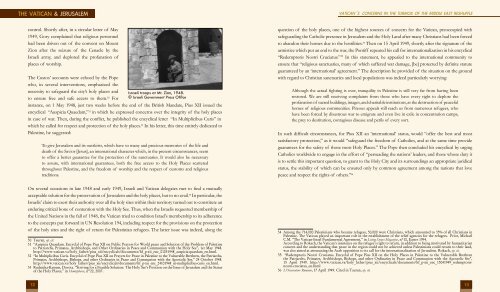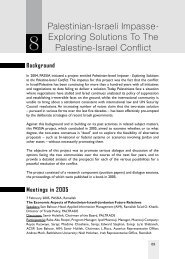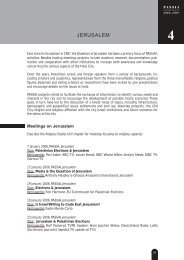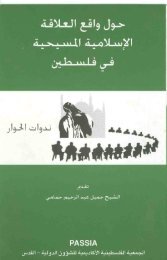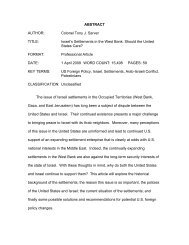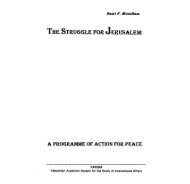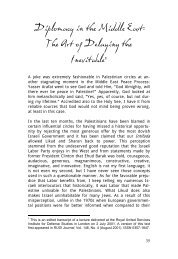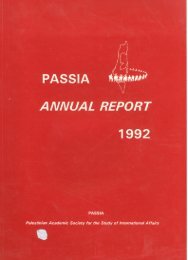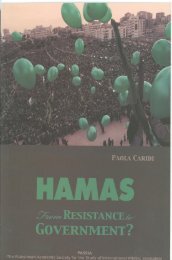The VaTican & Jerusalem - PASSIA Online Store
The VaTican & Jerusalem - PASSIA Online Store
The VaTican & Jerusalem - PASSIA Online Store
Create successful ePaper yourself
Turn your PDF publications into a flip-book with our unique Google optimized e-Paper software.
<strong>The</strong> Vatican & <strong>Jerusalem</strong>Vatican’s Concerns in the Turmoil of the Middle East Reshufflecontrol. Shortly after, in a circular letter of May1949, Gory complained that religious personnelhad been driven out of the convent on MountZion after the seizure of the Cenacle by theIsraeli army, and deplored the profanation ofplaces of worship.<strong>The</strong> Custos’ accounts were echoed by the Popewho, in several interventions, emphasized thenecessity to safeguard the city’s holy places andto ensure free and safe access to them. 30 ForIsraeli troops at Mt. Zion, 1948.© Israeli Government Press Officeinstance, on 1 May 1948, just two weeks before the end of the British Mandate, Pius XII issued theencyclical “Auspicia Quaedam,” 31 in which he expressed concerns over the integrity of the holy placesin case of war. <strong>The</strong>n, during the conflict, he published the encyclical letter “In Multiplicibus Curis” inwhich he called for respect and protection of the holy places. 32 In his letter, this time entirely dedicated toPalestine, he suggested:To give <strong>Jerusalem</strong> and its outskirts, which have so many and precious memories of the life anddeath of the Savior [Jesus], an international character which, in the present circumstances, seemto offer a better guarantee for the protection of the sanctuaries. It would also be necessaryto assure, with international guarantees, both the free access to the Holy Places scatteredthroughout Palestine, and the freedom of worship and the respect of customs and religioustraditions.On several occasions in late 1948 and early 1949, Israeli and Vatican delegates met to find a mutuallyacceptable solution for the preservation of <strong>Jerusalem</strong> and the holy places, but to no avail. 33 In particular, theIsraelis’ claim to exert their authority over all the holy sites within their territory turned out to constitute anenduring critical bone of contention with the Holy See. Thus, when the Israelis requested membership ofthe United Nations in the fall of 1948, the Vatican tried to condition Israel’s membership to its adherenceto the concepts put forward in UN Resolution 194, including respect for the provisions on the protectionof the holy sites and the right of return for Palestinian refugees. <strong>The</strong> latter issue was indeed, along the30 Tauran, op. cit.31 “Auspicia Quaedam. Encyclal of Pope Pius XII on Public Prayers for World peace and Solution of the Problem of Palestineto Patriarchs, Primates, Archbishops, and Other Ordinaries in Peace and Communion with the Holy See”, 1er May 1948.http://www.vatican.va/holy_father/pius_xii/encyclicals/documents/hf_p-xii_enc_01051948_auspicia-quaedam_en.html.32 “In Multiplicibus Curis. Encyclal of Pope Pius XII on Prayers for Peace in Palestine to the Vulnerable Brethren, the Patriarchs,Primates, Archbishops, Bishops, and other Ordinaries in Peace and Communion with the Apostolic See,” 24 October 1948.http://www.vatican.va/holy_father/pius_xii/encyclicals/documents/hf_p-xii_enc_24101948_in-multiplicibus-curis_en.html.33 Rudnicka-Kassem, Dorota. “Striving for a Feasible Solution: <strong>The</strong> Holy See’s Position on the Issue of <strong>Jerusalem</strong> and the Statusof the Holy Places,” in Hemispheres, n°22, 2007.question of the holy places, one of the highest sources of concern for the Vatican, preoccupied withsafeguarding the Catholic presence in <strong>Jerusalem</strong> and the Holy Land after many Christians had been forcedto abandon their homes due to the hostilities. 34 <strong>The</strong>n on 15 April 1949, shortly after the signature of thearmistice which put an end to the war, the Pontiff repeated his call for internationalization in his encyclical“Redemptoris Nostri Cruciatus.” 35 In this statement, he appealed to the international community toensure that “religious sanctuaries, many of which suffered war damage, [be] protected by definite statuteguaranteed by an ‘international’ agreement.” <strong>The</strong> description he provided of the situation on the groundwith regard to Christian sanctuaries and local populations was indeed particularly worrying:Although the actual fighting is over, tranquility in Palestine is still very far from having beenrestored. We are still receiving complaints from those who have every right to deplore theprofanation of sacred buildings, images, and charitable institutions, as the destruction of peacefulhomes of religious communities. Piteous appeals still reach us from numerous refugees, whohave been forced by disastrous war to emigrate and even live in exile in concentration camps,the prey to destitution, contagious disease and perils of every sort.In such difficult circumstances, for Pius XII an ‘international’ status, would “offer the best and mostsatisfactory protection,” as it would “safeguard the freedom of Catholics, and at the same time provideguarantees for the safety of those most Holy Places.” <strong>The</strong> Pope then concluded his encyclical by urgingCatholics worldwide to engage in the effort of “persuading the nations’ leaders, and those whose duty itis to settle this important question, to grant to the Holy City and its surroundings an appropriate juridicalstatus, the stability of which can be ensured only by common agreement among the nations that lovepeace and respect the rights of others.” 3634 Among the 714,000 Palestinians who became refugees, 50,000 were Christians, which amounted to 35% of all Christians inPalestine. <strong>The</strong> Vatican played an important role in the establishment of the relief agencies for the refugees. Prior, MichaelC.M. “<strong>The</strong> Vatican-Israel Fundamental Agreement,” in Living Stones Magazine, n°10, Easter 1994.According to Rokach, the Vatican’s insistence on the refugee’s right to return, in addition to being motivated by humanitarianconcern and the understanding that peace in the region could not be achieved unless Palestinians could return to their land,was also aimed at attenuating the Arab opposition to its call for the internationalization of <strong>Jerusalem</strong>. Rokach, op. cit.35 “Redemptoris Nostri Cruciatus. Encyclal of Pope Pius XII on the Holy Places in Palestine to the Vulnerable Brethrenthe Patriarchs, Primates, Archbishops, Bishops, and other Ordinaries in Peace and Communion with the Apostolic See”,15 April 1949. http://www.vatican.va/holy_father/pius_xii/encyclicals/documents/hf_p-xii_enc_15041949_redemptorisnostri-cruciatus_en.html36 L’Osservatore Romano, 17 April 1949. Cited in Tauran, op. cit.12 13


